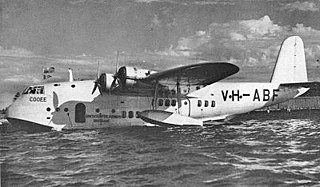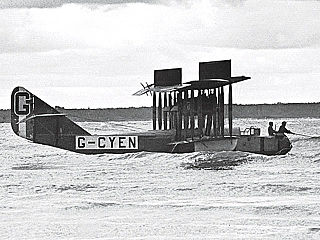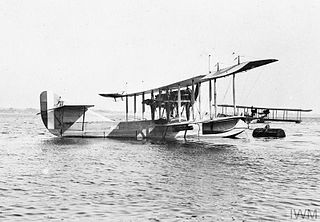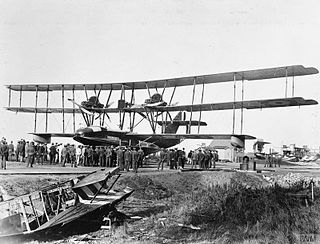
A flying boat is a type of fixed-winged seaplane with a hull, allowing it to land on water. It differs from a floatplane in having a fuselage that is purpose-designed for flotation, while floatplanes rely on fuselage-mounted floats for buoyancy.

A seaplane is a powered fixed-wing aircraft capable of taking off and landing (alighting) on water. Seaplanes are usually divided into two categories based on their technological characteristics: floatplanes and flying boats; the latter are generally far larger and can carry far more. Seaplanes that can also take off and land on airfields are in a subclass called amphibious aircraft, or amphibians. Seaplanes were sometimes called hydroplanes, but currently this term applies instead to motor-powered watercraft that use the technique of hydrodynamic lift to skim the surface of water when running at speed.

The twin-engine F5L was one of the Felixstowe F series of flying boats developed by John Cyril Porte at the Seaplane Experimental Station, Felixstowe, England, during the First World War for production in America.

The Felixstowe F.2 was a 1917 British flying boat class designed and developed by Lieutenant Commander John Cyril Porte RN at the naval air station, Felixstowe during the First World War adapting a larger version of his superior Felixstowe F.1 hull design married with the larger Curtiss H-12 flying boat. The Felixstowe hull had superior water contacting attributes and became a key base technology in most seaplane designs thereafter.

The English Electric P.5 Kingston was a British twin-engined biplane flying boat built by English Electric. When the English Electric Company was formed in 1918 from several companies, the Phoenix Dynamo Manufacturing Company brought with it the two prototype Phoenix P.5 Cork reconnaissance flying boats. Redesigned, the Cork reappeared as the English Electric P.5 Kingston with a production order for five aircraft.

The Felixstowe Porte Baby was a British reconnaissance flying boat of the First World War, first flying in 1915.
The Seaplane Experimental Station, formerly RNAS Felixstowe, was a British aircraft design unit during the early part of the 20th century.

The Felixstowe F.5 was a British First World War flying boat designed by Lieutenant Commander John Cyril Porte RN of the Seaplane Experimental Station, Felixstowe.

The Felixstowe F.3 was a British First World War flying boat, successor to the Felixstowe F.2 designed by Lieutenant Commander John Cyril Porte RN at the naval air station, Felixstowe.

Lieutenant Colonel John Cyril Porte, was a British flying boat pioneer associated with the First World War Seaplane Experimental Station at Felixstowe.

The Curtiss Model H was a family of classes of early long-range flying boats, the first two of which were developed directly on commission in the United States in response to the £10,000 prize challenge issued in 1913 by the London newspaper, the Daily Mail, for the first non-stop aerial crossing of the Atlantic. As the first aircraft having transatlantic range and cargo-carrying capacity, it became the grandfather development leading to early international commercial air travel, and by extension, to the modern world of commercial aviation. The last widely produced class, the Model H-12, was retrospectively designated Model 6 by Curtiss' company in the 1930s, and various classes have variants with suffixed letters indicating differences.

The Norman Thompson N.T.4 was a twin-engined British flying boat of the First World War. Although less well known than similar Curtiss and Felixstowe flying boats, 50 were ordered for Britain's Royal Naval Air Service.

Sir Charles Carrick Allom (1865–1947) was an eminent English decorator, trained as an architect and knighted for his work on Buckingham Palace. He was the grandson of architect Thomas Allom and painter Thomas Carrick. Among his American clients in the years preceding World War I was Henry Clay Frick, for whom Allom furnished houses in cooperation with Sir Joseph Duveen, the eminent paintings dealer. Allom furnished the Henry Clay Frick House at 71st Street and Fifth Avenue which today houses the Frick Collection, and the neo-Georgian house, Clayton, in Roslyn, Long Island, designed by Ogden Codman Jr., that was bought for Frick's daughter-in-law. For the grand rooms of parade in Frick's New York house, Sir Charles, whose London workshops produced the plasterwork and boiseries, kept the furnishings muted, not to compete with Frick's collection of paintings. In 1925, when William Randolph Hearst purchased a real castle, St. Donat's in Wales, his choice to furnish it fell upon Sir Charles.

The Felixstowe F.4 Fury, also known as the Porte Super-Baby, was a large British, five-engined triplane flying-boat designed by John Cyril Porte at the Seaplane Experimental Station, Felixstowe, inspired by the Wanamaker Triplane/Curtiss Model T. At the time the Fury was the largest seaplane in the world, the largest British aircraft, and the first aircraft controlled successfully by servo-assisted means.

The Supermarine Commercial Amphibian was a passenger-carrying flying boat. The first aircraft to be designed by Supermarine's Reginald Mitchell, it was built at the company's works at Woolston, Southampton, for an Air Ministry competition that took place during September 1920. Based on the Supermarine Channel, the Amphibian was a biplane flying boat with a single engine, a wooden hull, unequal wingspans and a 350 horsepower (260 kW) Rolls-Royce Eagle engine. The pilot sat in an open cockpit behind two passengers.

The Norman Thompson N.T.2B was a British single-engined flying boat trainer of the First World War. A single-engined biplane, the N.T.2B was adopted as a standard flying boat trainer by the Royal Naval Air Service, training pilots for larger patrol flying boats such as the Felixstowe F.2.

The Fairey N.4 was a 1920s British five-seat long range reconnaissance flying boat. Designed and built by the Fairey Aviation Company to meet an Admiralty requirement for a very large four-engined reconnaissance aircraft, it was the world's biggest flying boat when it first flew in 1923.

The Short N.3 Cromarty was a prototype British twin-engined biplane flying boat, designed towards the end of the First World War. Only a single example was built, which first flew in 1921 and was wrecked in 1922.

The Felixstowe F.1 was a British experimental flying boat designed and developed by Lieutenant Commander John Cyril Porte RN at the naval air station, Felixstowe based on the Curtiss H-4 with a new hull. Its design led to a range of successful larger flying boats that was assistance in promoting Britain as a leader in this field of aviation.

The Wanamaker Triplane or Curtiss Model T, retroactively renamed Curtiss Model 3 was a large experimental four-engined triplane patrol flying boat of World War I. It was the first four-engined aircraft built in the United States. Only a single example (No.3073) was completed. At the time, the Triplane was the largest seaplane in the world.




















